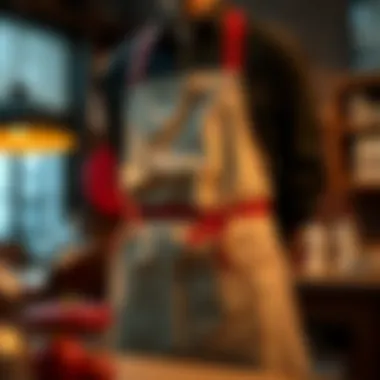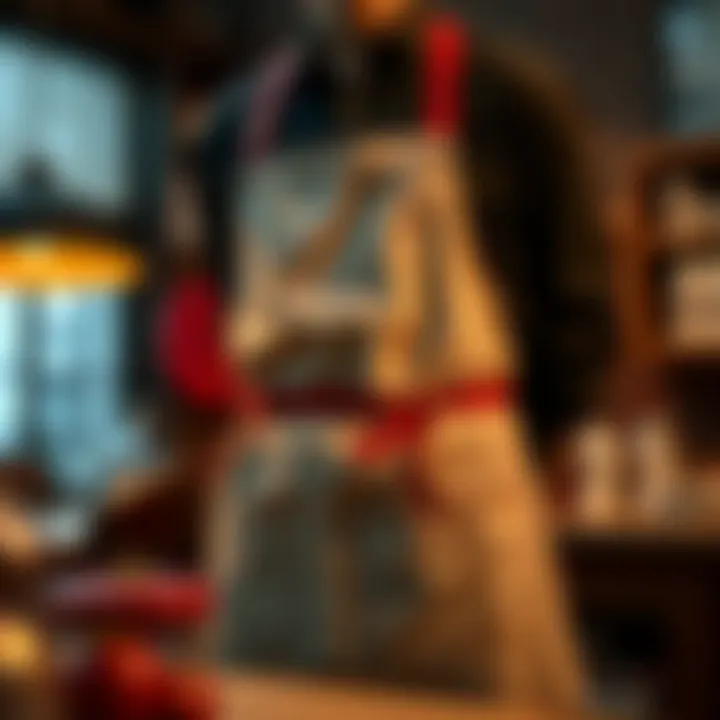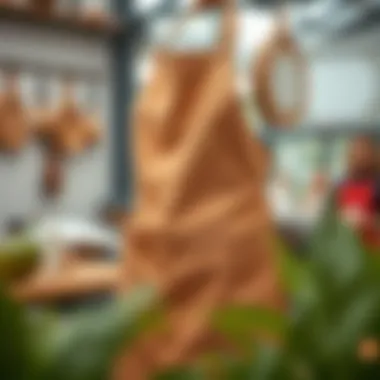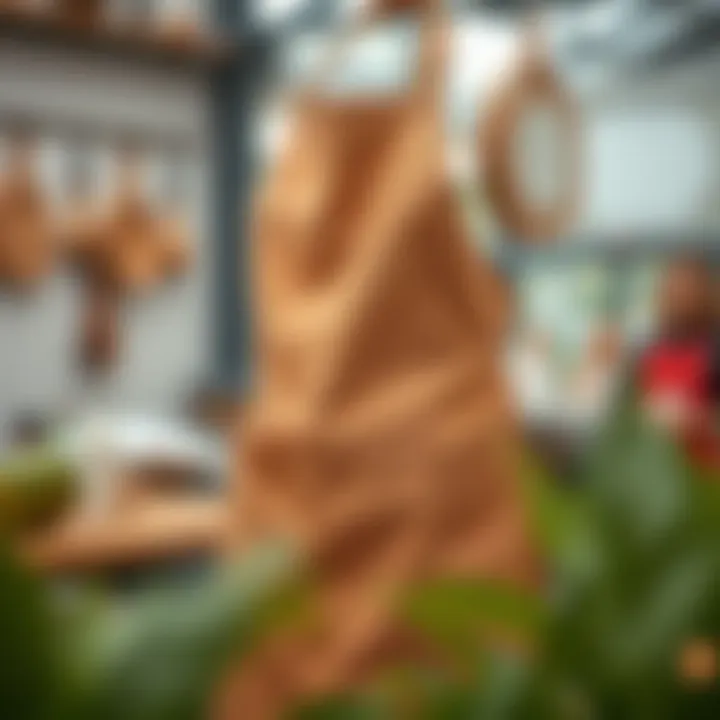Exploring the Tablier Apron: A Multifaceted Garment


Intro
The tablier apron, an often underestimated garment, brims with depth and versatility. Many think of it merely as protective wear for chefs or artists, yet its narrative stretches back centuries, intertwining with cultural identities and evolving practices. As we peel back the layers of the tablier apron, we uncover not just its utilitarian roots, but also its place in contemporary fashion and craftsmanship.
From rustic vineyards in France to lavish kitchens in New York, the tablier apron embodies a fusion of functionality and aesthetic appeal. It serves as a symbol of dedication—be it in culinary arts or creative endeavors, each stitch tells a story rooted in tradition, yet adaptable to modern demands.
Notably, with the increasing call for sustainability within fashion, the tablier apron emerges as an exemplar of this ethos. Designers today explore eco-friendly fabrics and ethical production methods, ensuring that this accessory not only complements an outfit but also aligns with the values of a more conscious consumer base.
In this article, we will traverse the landscape of the tablier apron, highlighting its historical significance, various styles, and the pivotal role it plays in creativity and culture. Along the way, we will also touch on current fashion trends associated with the garment and offer tips for how to style it, whether you’re preparing a meal or partaking in an artistic endeavor.
Prelude to the Tablier Apron
The tablier apron serves not just as a protective garment but as a canvas reflecting culture, creativity, and practicality. In many ways, it’s a silent witness to the daily toil and artistry of those who don it. This section aims to unravel the significance and the multifaceted nature of the tablier apron within the broader scope of fashion and functionality. A closer examination reveals how this simple article of clothing can elevate everyday activities, from cooking to crafting, making it an essential accessory in both domestic and professional spheres.
Definition and Characteristics
The term "tablier" originates from the French word for apron, which suggests a cloth to cover the front of one’s attire. Unlike regular aprons, the tablier apron typically features a more structured design, often extending from the chest down to the knees or beyond. At first glance, you might see a straightforward piece of fabric, yet the tablier stands out due to several key characteristics:
- Design: Most tabliers are specifically created with a symmetrical form, allowing for ease of movement while providing comprehensive coverage. Commonly, they have adjustable straps, which make them suitable for various body types.
- Pockets: Many versions come with pockets, practical for holding utensils, tools, or even personal items, merging style, and utility effortlessly.
- Fabric Choices: Tablier aprons are often made from diverse materials, ranging from classic cotton and linen to more contemporary synthetic options, catering to different settings and uses.
In simple terms, the tablier apron is not just another piece of fabric; it embodies the philosophy of merging aesthetic appeal with high functionality, making it a favored choice for cooks, artists, and DIY enthusiasts alike.
Historical Background
Understanding the history of the tablier apron offers insights into its evolving role. Historically, aprons have been around for centuries, serving various purposes, from protecting clothing to symbolizing profession and status. The tablier apron, as we know it, has roots that trace back to medieval Europe, where it was worn by workers and craftsmen in different trades.
Interestingly, in the Renaissance period, the tablier began to transition into a more fashionable accessory, often adorned with embroideries and rich fabrics, giving rise to an intersection of utility and style.
Furthermore, as industrialization took shape in the 18th and 19th centuries, the tablier apron found its place in kitchens and workshops around the world. It became not only a necessity for protecting against spills and stains but also a representation of the cultural fabric of the time. In many households, it represented care, nurturing, and hospitality.
"The apron is a symbol as much as it is a utility; it embodies the heart of home and craft."
Today, the tablier apron reflects both its historical significance and a modern sensibility. While it maintains its core function of protection, its designs have diversified, making it relevant in rigorous culinary environments as well as in casual kitchen settings at home.
In summary, this introductory look into the tablier apron sets the stage for a deeper exploration of its various styles, cultural significance, materials, and functionality in upcoming sections. Whether one views it as a simple garment or an intricate artifact of cultural evolution, the tablier apron is evidently a fascinating subject worthy of attention.
Design Variations of the Tablier Apron
When it comes to the tablier apron, one of its striking features is its design variability. This aspect not only showcases creativity in fashion but also encapsulates cultural significance and practical uses. The design variations of tablier aprons allow individuals to express personal style while still adhering to functional requirements. Each design tells a story, reflecting its original purpose and adaptation into the modern world. Let’s dive into the realms of classic styles, modern interpretations, and the cultural influences that shape these unique garments.
Classic Styles
Classic tablier aprons are often characterized by their traditional aesthetics and functional designs. They typically feature a square cut and can be seen gracing the kitchens of skilled chefs or the workshops of artisans. These styles often draw from historical designs that prioritize durability and ease of wear. The full-length options, for instance, cover the wearer from neck to knee, providing ample protection against spills and stains in culinary or art settings.
- Characteristics of Classic Styles:
- Simple yet elegant cuts
- Often made from sturdy materials like cotton or linen
- Minimalistic embellishments for functionality
- Practical pockets for tools and utensils
The nostalgic essence of these designs is appealing, evoking a sense of heritage and tradition. Many people cherish heirloom aprons passed down through generations, each carrying its unique history and memories.
Modern Interpretations


In contrast to classic styles, modern interpretations of the tablier apron embrace innovation and fashion-forward thinking. Designers have begun to incorporate elements such as asymmetrical cuts, unique patterns, and bright colors to make the apron not just a protective garment but also a fashion statement. The modern tablier can often be spotted in trendy cafes, art studios, and even fashion runways, where the functionality takes a backseat to style.
- Features of Modern Designs:
- Use of unconventional fabrics like polyester blends or denim
- Intricate prints and bright colors
- Tailored fits that enhance the silhouette
- Fashionable features such as adjustable straps and unique pocket placements
The ability of modern aprons to fuse function and flair means that they can easily transition from the workbench to dinner parties. They encourage self-expression, allowing wearers to showcase their personality while embracing the spirit of what it means to wear an apron.
Cultural Influences on Design
The construction and aesthetics of the tablier apron are also heavily influenced by cultural backgrounds. For instance, French tabliers often reflect the rustic charm of the countryside, including floral prints and soft hues, while their Japanese counterparts might embrace minimalism, with clean lines and subtle colors. These cultural influences lend additional layers of meaning and intrigue to the tablier.
- Global Examples of Cultural Influences:
- The Italian design often incorporates vibrant patterns, inspired by local markets.
- Scandinavian styles might emphasize functionality with utilitarian designs and neutral tones.
- Ethnic patterns, such as those from India, create vibrant, eye-catching designs that stand out in any setting.
The cultural diversity in apron design illustrates how clothing evolves through the daily lives of different communities. As people travel and share ideas, they bring their influences into their workwear, reaffirming that the tablier apron is not merely a garment but a canvas of cultural expression.
"The tablier apron serves not just as protection but as a reflection of the wearer’s identity and values, interwoven into the fabric of daily life."
In summary, the design variations of the tablier apron are a rich tapestry of history, culture, and style. By understanding these variations, fashion enthusiasts can appreciate the depth of this garment beyond its surface functionality. Each tablier apron has a unique story waiting to be told, contributing to the ongoing narrative of fashion and utility.
Materials Used in Tablier Aprons
The materials utilized in crafting tablier aprons are significant for various reasons, especially when considering the harmony of style, function, sustainability, and comfort. The choice of fabric not only affects the garment's durability and ease of care but also influences its overall appeal and suitability for different tasks. Fashion designers, stylists, and retailers alike should keep these elements at the forefront of their minds when sourcing or creating tablier aprons.
Cotton and Linen Fabrics
Cotton and linen remain popular choices for tablier aprons due to their breathability and versatility. Cotton, a staple in many wardrobes, is known for its softness and moisture-wicking properties. Here’s why these materials stand out:
- Comfortable Wear: Cotton feels good against the skin, making it ideal for long hours of use, whether in the kitchen, studio, or garden.
- Easy Maintenance: Both linen and cotton are relatively easy to care for. They can be machine-washed and dried with little fuss, an essential feature for busy individuals.
- Natural Aesthetic: The organic textures of cotton and linen can give an apron an artisanal charm, adding to its style quotient.
Linen, with its natural luster and crispness, often serves as the more upscale counterpart to cotton. It’s durable yet lightweight, making it perfect for warmer climates yet sophisticated enough for more refined occasions. However, linen tends to wrinkle easily, which some users may find off-putting. The choice between cotton and linen ultimately depends on personal preferences and intended use.
Innovative Synthetic Materials
In today’s fast-paced world, innovative synthetic materials are carving out a niche in apron production. Materials like polyester blends or nylon offer distinct advantages that deserve attention from fashion-forward individuals:
- Durability: Synthetic fabrics are often designed to withstand wear and tear, making them excellent options for those who require frequent use of their tablier aprons.
- Water Resistance: Many innovative materials provide a level of water resistance, ideal for culinary applications or outdoor use where spills are common. This quality can keep the wearer dry and protected.
- Lightweight and Packable: Synthetic options are typically lighter than natural fibers, making them easier to fold and pack for travel or storage.
While synthetic materials have their benefits, they also come with considerations like breathability. Choosing high-quality synthetic fabrics ensures that customers don't compromise on comfort, making these textiles a practical choice for various environments.
Sustainable Fabric Options
As sustainability becomes increasingly pivotal in fashion, the demand for eco-friendly materials in tablier aprons is on the rise. Fabrics derived from organic cotton, hemp, or recycled materials not only have environmental benefits but also appeal to conscious consumers. Here are some aspects to reflect on:
- Reduced Environmental Impact: Organic cotton is produced without harmful chemicals, benefiting both the environment and agricultural health. Similarly, recycled materials help reduce waste and promote circular fashion.
- Unique Textures: Fabrics like hemp offer unique textures that can give contemporary designs an earthy charm. Their naturally strong fibers also enhance durability.
- Transparency in Production: Eco-friendly practices often go hand in hand with ethical sourcing. Brands committed to sustainability tend to prioritize fair labor practices, a point that resonates well with modern consumers seeking ethical purchasing options.
In sum, no matter the material, the choice in tablier aprons reflects not only on practicality but also on a broader narrative of style and responsibility. Fashion designers and consumers alike must consider both aesthetic and ethical aspects as they navigate this multifunctional garment’s landscape.
"The future of fashion lies in recognizing the importance of materials that respect our planet and our bodies."
For more insights on sustainable fashion practices, you can visit resources like fashionrevolution.org or sustainablefashion.com.


Functionality in Various Settings
The tablier apron, in its many forms, serves not just as a piece of clothing but as a multifunctional tool that adapts to several environments. Its utility extends far beyond culinary spaces, bridging the gap between practical needs and aesthetic appeal. Understanding the various settings in which the tablier apron finds its place is paramount for fashion designers, stylists, and enthusiasts alike. Here’s how the apron stacks up in different contexts, making it an indispensable garment.
Culinary Applications
In the kitchen, the tablier apron is perhaps most recognized for its protective qualities. It provides a barrier against spills, stains, and splatters, safeguarding both clothing and skin. This functionality is vital for chefs and home cooks who want to maintain a semblance of cleanliness while engaged in food preparation.
- Material Selection: The choice of durable and heat-resistant fabrics, such as cotton or canvas, ensures the apron can withstand the rigors of a bustling kitchen environment.
- Pocket Utility: Many tablier aprons are equipped with pockets that are perfect for holding utensils, recipes, or even mobile devices, making them incredibly practical for culinary tasks.
- Adjustability: With adjustable ties or straps, these aprons can fit snugly and comfortably, allowing for ease of movement while chopping, stirring, or sautéing.
Moreover, the apron can be a canvas for personal expression, with various designs reflecting the cook's personality or culinary style. Whether it’s a whimsical flounce or a sleek contemporary cut, the tablier easily adapts to its wearer.
Artistic Pursuits
Moving from the kitchen to the studio, the tablier apron assumes another role—becoming an essential companion for artists. When dabbling in paint, clay, or other crafting mediums, the apron acts as an armor of sorts, protecting one's clothing from potential disasters.
- Versatile Use: Artists find the tablier apron handy for everything from painting canvases to sculpting with clay. Its ample coverage ensures that creative freedom isn't dampened by the worry of ruining clothes.
- Fashion Forward: Many artists choose aprons that are not only functional but also stylish, allowing them to project a unique image while they create. The textile used can enhance the creative vibe, making it as vital as the tools in their craft.
- Pockets for Tools: Like in culinary setups, pockets are crucial in an artist’s apron for holding brushes, palettes, and even notes, keeping all essentials within arm’s reach.
With its practical features, the tablier apron becomes an emblem of the creative spirit, marrying form and function in an aesthetically pleasing package.
Gardening and Outdoor Use
The functionality of the tablier apron spills over into gardening and outdoor realms, where it provides not only protection but also practicality.
- Durability Against Elements: Made with sturdy materials, the tablier can withstand dirt, moisture, and even wear from plants' sharp edges. This makes it an essential piece for green thumbs tending to their patches.
- Convenient Storage: Several garden aprons feature larger pockets for holding tools, seeds, or even a small trowel. With these pockets, there isn’t a need to keep running back to the shed for supplies.
- Stylish yet Practical: Wearing a well-designed tablier in the garden can also exude style. Gardeners can feel confident that they can move fluidly through their space while looking polished.
By exploring these various settings, one can appreciate how the tablier apron stands up to the tasks at hand—responding to the needs of cooks, artists, and gardeners alike. Its value transcends mere fabric, embodying the spirit of functionality and creativity.
"The tablier apron is not just an accessory; it’s a manifestation of our engagement with our craft, an intersection of utility and personal style."
For further discussions on the functionality and versatility of aprons in various settings, visit Wikipedia or explore related topics on Britannica and community insights on Reddit.
Tablier Apron and Fashion Trends
The tablier apron may initially conjure thoughts of culinary arts or messy craft projects, but its role in modern fashion is far more intricate. The fabric and cut of this utilitarian garment have found their way into everyday wardrobes, seamlessly merging practicality with style. As society grows more conscious about sustainability and individuality in fashion, the tablier apron represents a unique intersection where tradition meets contemporary needs. Whether worn by chefs in bustling restaurants or by hobbyists in their studios, this garment is being reimagined and embraced by a diverse range of people.
The Apron's Role in Modern Fashion
In the tapestry of modern fashion, the tablier apron has evolved from a simple protective garment to a fashionable staple. Fashion designers are increasingly inspired by its unique silhouette and functional design. This trend signals a shift where practicality is no longer at odds with style; instead, they are woven together with elegance. For instance, collaborative pieces seen in runway shows might incorporate luxurious fabric suited for high-end dining, or minimalist cuts found in urban streetwear, allowing for a versatility unseen in past decades.
"The revitalization of the tablier isn't just a whim; it's a testament to a growing acknowledgment of practical fashion."
The apron now adorns not just kitchens but also art exhibitions and fashion boutiques. Designers like Comme des Garçons and Issey Miyake have captured the essence of this garment, enhancing it with bold colors and unconventional lines, thereby inviting a broader audience to appreciate its beauty and utility. It's all about shifting perceptions; an apron today can be a bold style statement, providing the wearer with an air of creativity and flair.
Styling Tips for Everyday Wear
Dressing with a tablier apron can be both functional and fashionable. Here are a few tips to keep in mind:
- Layer Wisely: The tablier apron works excellently layered over a simple shirt or a fitted dress. Opt for neutral tones that can pair with a variety of outfits. For example, a well-fitting black tablier will elevate a plain white tee effortlessly.
- Accessorize Thoughtfully: Use accessories to draw attention away from the bulk of the apron. A statement necklace can add flair, whereas a belt can cinch the waist, giving more shape to your look.
- Playing with Textures: Don’t shy away from mixing different materials. For instance, denim tabliers paired with flowing linen or cotton tops can create a dynamic visual appeal.
- Footwear Matters: The choice of shoes can make or break the outfit. Pairing the tablier apron with sleek ankle boots or stylish loafers can lend an overall polished look.
Care and Maintenance of Tablier Aprons


Caring for a tablier apron is essential not just for its longevity but also for maintaining its aesthetic appeal. This section focuses on practical strategies for washing and storing these versatile garments, tailored specifically to the distinct materials used in their construction. The care practices not only enhance durability but also uphold the apron’s functionality across various activities, ensuring it remains a staple in both culinary and artistic environments.
Washing Techniques by Material Type
Different materials used in tablier aprons call for specific washing methods to preserve their integrity and appearance. Here’s a quick overview:
- Cotton and Linen: These natural fibers are usually machine washable. Use cold water to prevent shrinking and preserve color. A gentle cycle is advisable, and it’s best to avoid harsh detergents. After washing, let them air dry to prevent any potential shrinkage from heat.
- Synthetic Fabrics: Materials like polyester can withstand warmer temperatures but are often stain resistant. Washing synthetic fabrics in warm water helps maintain their color and structure. Make sure to turn the apron inside out to reduce fading and wear on the outer surface during washing.
- Sustainable Fabrics: Eco-friendly materials often require delicate handling. Follow care labels closely, as some may be compatible with hand washing only. Use biodegradable detergents to align with sustainable practices and prolong the life of both the fabric and the environment.
"Proper care of your tablier apron not only reflects your respect for the garment but also enhances its utility across varied contexts."
Storage Recommendations
Storing tablier aprons appropriately is another critical aspect of maintaining their quality. Here are some effective storage techniques:
- Folded Storage: For aprons that see frequent use, folding them neatly and storing them in a drawer keeps them wrinkle-free and ready for action.
- Hanging Storage: If space allows, hanging aprons on hooks or hangers can help avoid creases, making them easily accessible. This method also allows for air circulation, preventing any residual dampness from causing mildew.
- Climate Considerations: Store aprons in a cool, dry place. Humidity can warp fabrics and affect the finish, particularly for those made from natural fibers. A cloth storage bag can offer an extra layer of protection against dust and moisture.
By taking care of your tablier apron through the right washing techniques and storage methods, you can ensure that it remains both a practical and stylish choice for any occasion.
Sustainable Practices in Apron Manufacturing
As the conversation around sustainability intensifies in the fashion industry, it becomes increasingly vital to explore the sustainable practices within apron manufacturing. The tablier apron, traditionally recognized for its practicality, holds the potential to further champion eco-friendly efforts. By integrating sustainable methods in both sourcing materials and production processes, the apron can evolve beyond its utilitarian roots, becoming a symbol of conscious consumerism.
Ethical Sourcing of Materials
Ethical sourcing is the backbone of sustainable practices in apron manufacturing. This involves selecting materials that not only meet quality standards but also align with ethical principles. Fabrics like organic cotton or linen represent a step in the right direction. Sourcing these materials from suppliers who emphasize fair labor practices allows brands to reduce their carbon footprint while promoting social equity.
In addition to the quality of fabric, attention should be given to the entire supply chain. For example, brands can collaborate with farmers who practice regenerative agriculture, which enhances soil health and promotes biodiversity. Implementing transparency measures can help consumers understand where and how their aprons are made. By supporting local artisans or using regional materials, the ecological impact of transporting goods is minimized, contributing to sustainability.
"When consumers choose products made from ethically sourced materials, they are not just buying a product; they are investing in better practices and a healthier planet."
Eco-Friendly Production Methods
Production methods must also be scrutinized for their sustainability impact. Brands can benefit from adopting eco-friendly techniques such as low-water dyeing processes. Conventional dyeing can consume large amounts of water and chemicals, but innovative techniques can drastically reduce waste.
Utilizing renewable energy sources during production is another game-changer. Factories powered by solar or wind energy significantly lessen their environmental impact. Additionally, optimizing the production process to minimize fabric waste is crucial. Implementing patterns that maximize fabric usage can lead to a reduction in offcuts, which often end up in landfills.
In terms of packaging, brands should opt for biodegradable or recyclable materials rather than plastic that sits in landfills for centuries. By ensuring that all steps— from raw material acquisition to packaging— are accounted for, the tablier apron can become more than just a garment; it transforms into a responsible choice in the broader context of fashion.
To summarize, sustainable practices in apron manufacturing hinge on ethical sourcing and eco-friendly production methods. Fashion designers, stylists, and retailers are called to recognize the importance of these practices. Together, they can pave the way for a future where the tablier apron not only serves its traditional purpose but also champions the cause of sustainability in fashion.
The Future of the Tablier Apron
As we look ahead, the future of the tablier apron presents a fascinating landscape of innovation and adaptability. Its evolution reflects not just changing trends in fashion but also a growing awareness of sustainability and practicality within the garment industry. The tablier apron is set to play a significant role in various contexts — be it culinary arts, creative hobbies, or even casual everyday wear. This continual transformation is important as it underlines the apron’s function as not only a protective garment but also a statement of style and culture.
Emerging Trends and Innovations
Several trends are shaping the future of the tablier apron that go beyond mere style. Among these are the incorporation of smart fabrics, which are engineered to offer unique properties like stain resistance and moisture-wicking capabilities.
- Smart Textiles: Imagine an apron that can resist spills or stains through advanced textiles that have been developed in recent years. This innovation takes functional garments into a new realm, catering to the bustling environment of modern kitchens and studios where messes are inevitable.
- Functional Design: Ergonomics matters more than ever. Designers are embedding features such as adjustable straps, multipurpose pockets, and even detachable elements that allow individuals to customize their aprons based on their activities.
- Personalization: With the rise of custom designs, consumers will increasingly demand aprons that reflect their personal style. This could mean anything from unique patterns to embroidered names or initials, making fashion more intimate and meaningful.
- Sustainability: As awareness grows about environmental impacts, the trend toward sustainable materials is becoming critical. Brands are increasingly sourcing organic cotton or bamboo and employing low-impact dyes that align with eco-friendly production principles.
"The tablier apron is not just a piece of clothing; it is a canvas for innovation, style, and sustainability."
Cultural Shifts and Impact on Design
Cultural shifts are also crucial in shaping the future fabric of tablier apron design. These garments are transcending their traditional confines, becoming symbols of identity and creative expression. The increasing popularity of home cooking and artisanal baking during the global pandemic has dramatically elevated the apron’s status. This shift has led to a renewed appreciation for craftsmanship, prompting makers to consider historic inspirations alongside contemporary aesthetics.
- Global Influences: As travel becomes more accessible, diverse cultural elements are encroaching on design choices. This fusion creates exciting variations that honor origins while catering to modern sensibilities. One might see elements from Mediterranean styles clashing beautifully with minimalist Scandinavian designs.
- Identity & Gender Fluidity: The modern apron is shedding traditional gender norms. It's now common to see designs that cater to all genders, embracing inclusivity wherever possible. This cultural shift encourages designers to think outside the box, providing a rich palette for creativity.
- Social Media Effect: Platforms like Instagram and Pinterest are changing the way individuals perceive fashion. Aprons are frequently featured in culinary posts, focusing on aesthetics as much as functionality. This trend encourages brands to amplify their designs to appeal to the visually-driven consumer.
As we step into an era highlighted by technological advancements and cultural sensitivity, the tablier apron seeks to maintain its charm as a blend of utility and creativity. The trends shaping it will influence how people connect with their activities, whether in the kitchen, studio, or garden.















